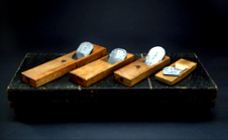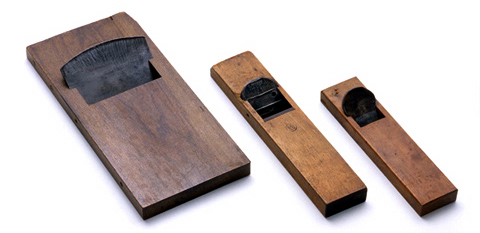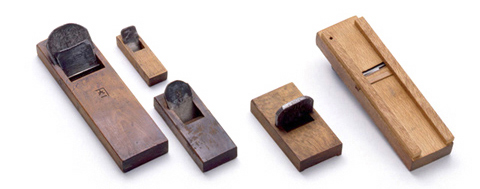Plane [kanna]
Kanna
Kanna

Planes for smoothing surfaces such as boards and square materials. There is one blade and two blades. The plane was originally a single blade, but in the latter half of the Meiji era, a two-plane (combined plane) with a holding blade to prevent the reverse side was devised and became common. At present, single planes are used for high-end finishes that make the luster.
Flat planes can be used for rough work planes for rough cutting materials, medium work planes for smooth surfaces, and finishing planes for finishing the last finish. In order to make a rough plane, the number of plane blades is slightly larger, and the blade mouth is wider so that thick scraps are produced. In the order of medium-sized construction planes and finishing planes, the cutting edges are reduced and the blade edge is narrowed. The lower end of the table is also adjusted according to each other.
Of the flat planes, those with a blade width of 3 inches or more are called large planes, those with a short stand of 1 inch and 8 minutes or less are called small planes, and those with a very small stand are called bean planes (planes other than flat planes) In each type, small ones are called small planes and extremely small ones are called bean planes). In addition, with the normal blade width, those with a stand of about 40 cm are called long stand planes, and those around 35 cm are called Nakadai planes.

Large plane, long plane, middle plane from left
A plane with a plane blade installed at almost right angle (90 degrees) on a table. With a single blade, the table is shorter than a normal flat plane. A plane is an unavoidable tool that needs to accurately adjust the lower end of the table. The table fixing plane is used when cutting and modifying the lower end of the plane stand. Also, hard trees such as ebony and ebony are used in Shaving.
A plane for cutting several Kumikos such as shoji door at the same time. There is a Ruler that can be removed on both sides of the lower end of the plane, and several Kumikos can be cut according to the thickness of the Ruler. By replacing the Ruler, various dimensions can be cut. In order to prevent the kumiko from floating up during work, a spring-gigged pressed tree is installed near the blade edge, and the material surface is pressed downward.

From the left, flat plane, bean plane, small plane, plane plane plane (back)
Basic information
Special Exhibition
Permanent exhibition